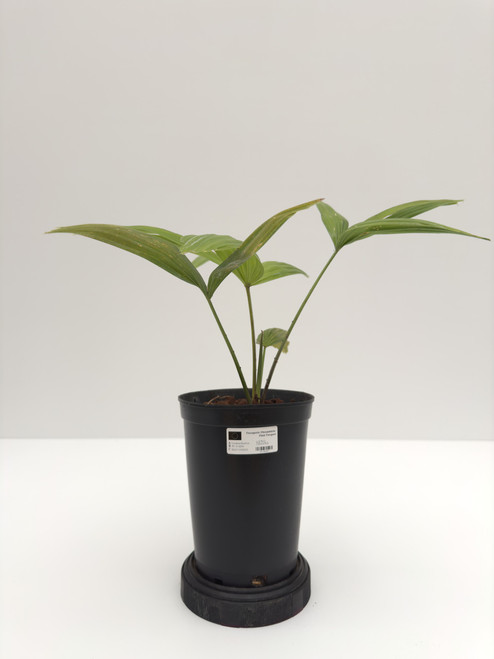Product Description
Habitat and Distribution
Bangladesh, Chittagong; Burma, Pegu Yoma and Tenasserim; China, Guangdong, Fengkai, and Hainan Is. at Mo San; throughout Thailand at 400-900 m alt.; and Peninsula Malaysia, on Langkawi Is., Gunung Inas to Genting Sempah in the west and Gunung Stong and Gunung Mandi Angin in the east at 700-1200 m alt. Moderately common in moist to wet Forest. In high rainfall areas in moist evergreen forest, at 200-3000 m altitude. (Dowe, J.L.)/Palmweb.
Description
Hermaphroditic, Solitary palm. Trunk to 25 m tall, 20-30 cm in diameter, breast high, leaf scars lightly raised, light grey, petiole stubs sometimes persistent, particularly at the base, otherwise smooth, longitudinal fissures not evident. Leaves 40-50 in a globose or oblong crown; petiole slightly arching, 140-159 cm long, 20-25 mm wide distally, adaxially slightly concave to flat, abaxially convex, margins armed throughout with single retrorsely, recurved orange-brown spines to 25 mm long, to 10 mm wide at the base, base frequently swollen, apically acute, spines reducing in size to tubercles toward the apex; leafbase fibres moderately prominent, coarse, persistent; appendage to 25 cm long; lamina costapalmate, regularly segmented, circular to subcircular in outline, 150-200 cm long, to 200 cm wide, adaxially green, abaxially glaucous grey; lamina divided for 25-75% of its length, with about 100 segments, depth of apical cleft 3-4% of the segment length, 3.5-8 cm wide where the segments diverge, apical lobes rigid; basal segments overlap at the hastula; parallel veins 9-10 each side of midrib; transverse veins thinner than parallel veins; hastula cordate. Inflorescences unbranched at the base, 120-200 cm long, not extending beyond the limit of the crown, branched to 4 orders; partial inflorescences 3-6, 40-60 cm long; prophyll 30-45 cm long, woody, keeled; peduncular bract(s) lacking; rachis bracts loosely tubular, reddish-brown, glabrous, expanded distally into lanceolate acuminate lobes, sometimes longitudinally split, scurfy to glabrous; rachillae 10-20 cm long, 3-4 mm in diameter, spreading to drooping or rigid, yellow-green, glabrous. Flowers in clusters of 5-6, sessile, greenish cream, carried on small, sessile tubercles, broadly ovate in bud, to 2.5 mm long; sepals fused basally, fleshy, 1.2-2 mm long, 1.3-1.5 mm wide, semi-ovate, subacute, with subhyaline margins; petals basally fused, thick, deltoid, acute, 2.5-4 mm long, 2.5-3 mm wide; stamens with briefly basally fused filaments, partly adnate to the petals, thick and short, contracted into elongate apices, connective very short, narrow; anthers suboribiculardidymous; carpel turbinate-obconical, yellow, distinctly sculptured, and contracted into a short trisulcate, filiform style to 2.5 mm long, stigma simple. Fruit obovate, obpyriform, to ovoid, rounded apically, narrowed basally, 25-35 mm long, 18-25 mm in diam., greenish-blue to light-blue at maturity; epicarp less than 1 mm wide, with scattered lenticellular pores; suture line extends full length of the fruit, marked with lip-like structures; mesocarp thinly woody, brittle, whitish within; endocarp woody, brittle, to 1 mm wide. Seed oblong-elliptical, rounded at both ends, to 17 mm long, to 12 mm wide; intruded to more than half the width of the endosperm; embryo lateral. Eophyll 7- ribbed. (Dowe, J.L.)/Palmweb. Editing by edric.
Culture
Growth rate: slow. Sunlight: gradual sun. Water: keep moist. Cold Tolerance: 26° F. Hardiness, zone: 9b
Comments and Curiosities
Phenology: Flowers Jul-Aug; fruits Oct-Nov.
Conservation: Near threatened. (Dowe, J.L.)
This beautiful and stately palm from the montane forests of Thailand, Burma, and Malaysia produces a dense crown of very large, flat, circular leaves that are only shallowly divided, and a tall, columnar, gray trunk. The large seeds are easy to germinate and plants are suitable for a wide range of climates, from warm temperate to tropical. It is still rarely seen in cultivation, but has enormous potential as a landscape plant. Livistona speciosa is quite similar to L. jenkinsiana. (RPS.com)














